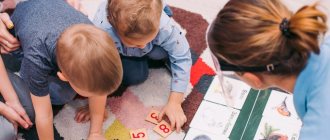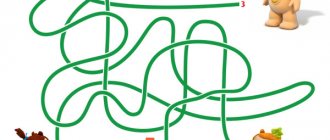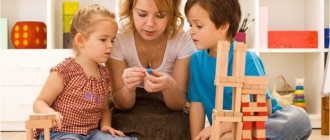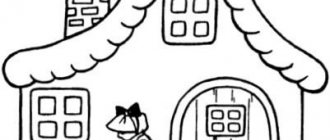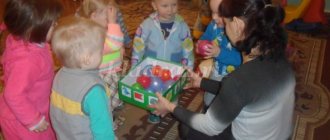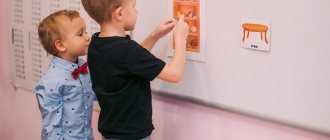How to develop logical thinking in a child
Children are capable of reasoning; they are able to form logical connections between knowledge and interaction. Reasoning is a skill that develops when children are given the freedom to spend time on their own and build their own thinking processes. This ability to reason arises at different ages depending on the individual abilities of the child; the development of logical thinking in preschoolers develops in preparatory classes for school, and the development of thinking in preschool children and the development of thinking in younger schoolchildren can begin from the beginning of school. However, the development of logic manifests itself in every child eventually.
Start of thinking
The leading type of thinking in children of senior preschool age is experience, which is a catalyst that allows the development of logical reasoning. First of all, the child manifests thinking, which is transformed into the ability to think logically, study, analyze information and solve problems. For some children they learn to reason quickly, for others it requires repeated activities to form patterns and logical connections and subsequently develop abstract logical thinking.
Example
Let's look at this example: While studying, a child who is a self-learner must explore concepts and form connections to understand a topic. On the other hand, a child raised by mentoring cannot form these connections on his own. Thus, a child who is used to coaching will not have the same result as a self-learner because he cannot study on his own. A self-learner who understands his preferred learning style will find coaching (or mentoring or working with a teacher) unnecessary and a waste of time.
How to develop
How to develop thinking in children? Logical reasoning requires independence. As parents and teachers, if we try to trust children and their decisions, we can help develop their logical reasoning. By trying to find their answers, children begin to develop the ability to reason logically. Conversely, if we do not trust them and tirelessly share our suggestions, beliefs, experiences and strategies with them, they will become dependent on others. They will not form their own conclusions and their logical side will remain undeveloped.
When children are given the freedom to learn, they learn what, why and how, and at different ages different types of logic and thinking.
- At the age of 3-4 years, children may reason that they need to act, but their actions do not correspond to the task. They start responding immediately; act indiscriminately to solve a problem without actually analyzing the circumstances. Preschoolers cannot understand the terms of the problem, which means that they cannot critically assess the situation. This ultimately leads to trial and error, a valuable form of experience. Logical reasoning begins to develop after these practical attempts at problem solving.
- Logic for children 5-6 years old - the age when children begin to understand problems and look for ways to solve them; they begin to use logical reasoning. This is especially evident as children in this age group begin to use language as a basis for logical reasoning. Arguments form the basis of their reasoning and their determination to solve intellectual problems. These children learn to convey what they feel and think; they discover a range of modes of communication and their relationship to reasoning and response. They begin to reason and draw conclusions. Children's logical and critical thinking has now evolved.
Games and exercises to develop logical thinking in preschoolers
Children's games to develop logic will be useful at any age. Here are some examples of such games and exercises.
"The Game in Reverse"
An adult says a phrase that contains a deliberately incorrect message. The child must quickly correct it. Depending on age, you can complicate the original phrases. For example, the little ones understand that the phrase “The snow is hot” should be immediately answered: “Cold”; “Tomato blue” - “Red”. And older children can already compare and answer the phrase “An elephant is smaller than a mosquito”: “More.”
The good thing about this game is that it can be played by an unlimited number of children. In addition, kids are always very cheerful and readily “correct” adults.
"Extra item"
The Find the Odd One game is also a fun activity suitable for all ages.
Pictures or objects are collected in one place (box, hat) according to some principle, and one extra object is thrown there. It needs to be identified and named.
Tasks can be very simple or more complex. For example, for kids you can throw a ball into a box of fruit, and for older children you can put a vegetable in the same fruit.
In this case, in a playful way, the child learns to analyze objects, identify common and different features, and acquire classification skills.
“What does it look like?”
Play association games with your child. Let him say what this or that object reminds him of. You can start with the simplest (an orange is a ball, a potato is a pebble) and gradually move on to more complex associations: what does a rainy sky, a fluffy kitten, a mitten, a table look like?.. The more surprising the association, the better.
Don’t try to tell your child a trivial answer: even if you don’t think that ice cream looks like a balloon, it’s okay, it’s important that the child develops his own images.
This game is more suitable for average preschoolers.
"What does it mean?"
A lightweight version of a full-fledged logic game.
Invite your child to continue the phrase in as many ways as possible: “I took candy from the table. What does it mean?" Options, for example, could be: “There is no more candy on the table”, “The candy is now in my hand (pocket)”, “There are fewer candies on the table”, “I have stained my hand with chocolate”...
The more options are born, the more amazing they are. This game is not for the youngest, but at 4-5 years old children already play it with pleasure.
“Complete the drawing”
The simplest creative task. You can draw any figure (squiggle) on the sheet and invite the child to complete the drawing, so that this figure is definitely involved. For younger children, you can depict something quite recognizable, but not completed, and for older children, do not limit your imagination.
"Find a Pair"
Make pairs of pictures that are logically related to each other. Divide into two piles. Let the child find a pair for each item.
For younger children, you can choose simple options: tree - leaf, fish - aquarium. Older children can cope with a more complex task - for example, “picking up” a syringe for the doctor.
"Item Description"
You name the object, and the child must choose as many epithets for it as possible. For example, a Christmas tree: prickly, tall, beautiful, elegant, green.
The reverse option is also interesting. What could be prickly? The same tree, hedgehog, needle, snow, scarf... The more associations, the better.
The game, of course, is not for the little ones.
"Find the sequence"
For children who can count to at least 10, you can create an elementary number sequence, where each subsequent number is greater/less than the previous one (by a certain number).
2 - 4 - 6 - ...What's next?
9 - 7 - 5 - ...What's next?
Older preschoolers will enjoy pattern-finding games not only with numbers, but also with pictures.
"The Most Necessary Items"
Invite your child to go to the countryside / desert island / on a trip around the world, taking with him only things, for example, with the letter “k” or green, and no more than 10 pieces. Let him explain why he needs this or that thing.
Besides being fun, it's also a good way to test your child's ability to predict future events.
There are many types of developmental activities. Which one to choose depends only on the imagination of adults and the inclinations of children. Some children perceive information better in verbal form, others - through illustrations. The main thing is that the child is interested, so that he gets involved in the process of finding a solution, and begins to think: “Why is this so?” and “What if?”
Logic and mathematics for children
We develop logical thinking, teach you how to work with information and make the right decisions in an interactive game format.
Learn more.
Games
Logical thinking games for preschoolers
If you've ever tried to reason with a three-year-old, you know that a child at that age doesn't think logically. Young children are very concrete and literal in their thinking, and only as they approach school age do they begin to demonstrate a readiness for tasks that require more abstract thinking. However, preschoolers often make surprising connections as they explore and make sense of the world, and there are several fun logic games that will answer your child's question: What is logic?
The thinking of a 4–6 year old child: what is it like?
Mental activity is the ability to establish connections and relationships between phenomena and objects and draw conclusions. And it does not exist separately from the psyche as a whole, but is connected with all the processes that occur in the baby’s mind. And there are many of them, because at this age a child discovers and learns about the world.
Fundamentals of mental activity of a preschooler. Prerequisites for abstract-logical thinking
Speech
Perhaps the most fundamental role in the mental development of a preschooler is played by comprehension of the art of speech or, as psychologists say, the sign function of consciousness. Words-signs are the most important tools of thinking. And the better the baby speaks, the more successful the development of his thinking will be.
And the point here is not only in vocabulary, but also in mastering the entire grammatical structure of speech. Thus, knowledge about the genders of nouns is associated with:
- the most complex analysis of a wide variety of information;
- understanding the connections and relationships of living beings;
- transfer of certain characteristics (kind) from one object to another, including from living to inanimate.
And this requires abstract thinking. Knowledge and use of definitions, additions and circumstances, complication of sentences makes not only speech, but also thinking richer.
Perception
Any information about the external world is material for thinking, and the channel through which this information enters the brain is perception. At preschool age, children are already more attentive, they are able to consciously concentrate, and they are interested in many things in the world around them:
- enjoy looking at flowers and clouds floating across the sky;
- notice a change in leaf color in the fall;
- love to watch kittens and puppies, butterflies and birds;
- listen to music with interest;
- they taste things that are sometimes inedible from the point of view of adults.
Kids actively accumulate material to develop their thinking. Of great importance is their need to connect speech to the process of cognition, to give “names” to everything they see and feel, to describe, to tell. Often children do not have enough words for this, and they turn to adults who must help. The designation of things and phenomena, objects and actions is a significative function of speech; it is very important for the development of thinking, first of all, conceptual, abstract-logical.
Mastering sensory standards
In preschool age, an important role is played by understanding sensory standards, that is, ideas formed in society about the characteristics of things, their properties, and relationships. The simplest sensory standards include:
- geometric figures,
- colors,
- temperature characteristics,
- sizes, etc.
Understanding and operating with sensory standards (distinguishing colors, geometric shapes, comparative characteristics of sizes and weights, etc.) is a very important prerequisite for the development of abstract logical thinking. Thus, understanding that the sun drawn in the picture is round and the house is square requires preliminary complex mental work: analysis, comparison, highlighting the characteristics of the standard (circle or square), abstracting (separating) this characteristic and transferring it to another object.
It is also important that the standards are interconnected by complex relationships, the understanding of which is an important step in the development of children’s abstract thinking. For example, pyramid rings can be put on a stick, but circles cannot; a triangular roof can stand on a square house, but not on a round ball.
Mastery of subject activity
This is another important prerequisite for the development of thinking. Children don't just play with objects, they study their properties and features. Until the age of 4, a child’s thinking occurs primarily in objective activities, in the process of games, and manipulation of things. In early childhood, only visual and effective thinking is possible in children. And when they do not play with objects, there is no mental activity.
There is one more important point. In the process of evolution, it turned out that hands are of fundamental importance for humans, therefore, on the palms and fingertips there are a huge number of points associated with different parts of the brain. As psychologists say, by training fine motor skills of the hands, the child develops the brain.
In preschool age, children love to do everything with their hands:
- molded from plasticine, dough and mud;
- draw on paper and walls;
- They enthusiastically collect Legos.
Their hand movements become more precise, coordinated, and with them their thinking becomes more developed and complex.
All these changes are important prerequisites for the complication of mental activity; visual-effective thinking is replaced by figurative thinking - more complex and already abstract thinking.
In the world of images
Images occupy the main place in the thinking of children of this age; in fact, they perform the function of signs, the role of which will later be played by words. The speech form of thinking also exists, but it is not yet independent and is subordinate to images, depends on them and is determined by them. That’s why children love bright pictures so much and enjoy drawing. Some psychologists even believe that drawing partly replaces abstract thinking in children and creates the basis for it. Therefore, visual arts activities greatly contribute to the development of children's thinking.
- Unlike visual-effective thinking, imaginative thinking already allows you to be distracted from a specific situation and even fantasize. At this age, the imagination is so bright and vivid that, with the weakness of rational thinking, children sometimes mistake the images of their imagination for real beings. Remember "Carlson, who lives on the roof." This is a completely realistic story about a boy and his imaginary friend.
- Images are involved in all mental operations, and for the child they are still more important than abstract concepts. But children are already able to understand schematic images, for example, a circle, an oval and four sticks for it depicted on a piece of paper will be unmistakably called a man. And if you explain to them what a plan is, then they enthusiastically begin to draw a house plan and “place” furniture, doors, windows, and toys in it.
At preschool age, children are able to solve quite complex logical problems, however, if they can operate with images. For example, when listening to a fairy tale about Kolobok, they unmistakably come to the conclusion that it was his own fault that Kolobok was eaten - there was no need to run away from his grandparents. True, they cannot yet bring the fairy tale to a different logical conclusion - because otherwise Kolobok would have been eaten by his grandparents.
Using images, children successfully cope with all logical operations:
- analysis,
- comparison,
- comparison,
- synthesis.
We can say that imaginative thinking itself contains the prerequisites for mastering logical thinking. And by the end of preschool age, these two types of thinking coexist perfectly and complement each other.
What does logic use?
What is logical thinking and what basic concepts does logic use?
Logical thinking is thinking that involves reasoning and using what you know to draw conclusions. Logical thinking is the basis of cognition. This requires an understanding of attributes, relationships and sequencing, and is not only important for formal learning; it is a necessary life skill. Logic is, in simple words, the rational mental activity of a person. And logically it is consistent. Logical-reasonable.
General rules for the development of logic in a child
The main activity in preschool age for a child is play. However, despite this, logic plays an important role for preschoolers. Imagination during this period is not yet well developed and in order for learning to be easier and more effective, during classes it is necessary to use a maximum of visual material: toys, pictures, puzzles, counting sticks, etc. Bright didactic material will turn any activity into an exciting game in which the child will be happy to take part.
Geometric shapes - developing logic in a playful way
As the child grows up, he will need demonstration material less and less. And the solution of more and more problems will take place in the mind, using verbal and logical thinking.
